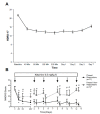Therapeutic Modulation of Glutamate Receptors in Major Depressive Disorder
- PMID: 26997505
- PMCID: PMC5327449
- DOI: 10.2174/1570159x14666160321123221
Therapeutic Modulation of Glutamate Receptors in Major Depressive Disorder
Abstract
Current pharmacotherapies for major depressive disorder (MDD) have a distinct lag of onset that can prolong distress and impairment for patients, and realworld effectiveness trials further suggest that antidepressant efficacy is limited in many patients. All currently approved antidepressant medications for MDD act primarily through monoaminergic mechanisms, e.g., receptor/reuptake agonists or antagonists with varying affinities for serotonin, norepinephrine, or dopamine. Glutamate is the major excitatory neurotransmitter in the central nervous system, and glutamate and its cognate receptors are implicated in the pathophysiology of MDD, as well as in the development of novel therapeutics for this disorder. Since the rapid and robust antidepressant effects of the N-methyl-D-aspartate (NMDA) antagonist ketamine were first observed in 2000, other NMDA receptor antagonists have been studied in MDD. These have been associated with relatively modest antidepressant effects compared to ketamine, but some have shown more favorable characteristics with increased potential in clinical practice (for instance, oral administration, decreased dissociative and/or psychotomimetic effects, and reduced abuse/diversion liability). This article reviews the clinical evidence supporting the use of glutamate receptor modulators with direct affinity for cognate receptors: 1) non-competitive NMDA receptor antagonists (ketamine, memantine, dextromethorphan, AZD6765); 2) subunit (NR2B)-specific NMDA receptor antagonists (CP- 101,606/traxoprodil, MK-0657); 3) NMDA receptor glycine-site partial agonists (D-cycloserine, GLYX- 13); and 4) metabotropic glutamate receptor (mGluR) modulators (AZD2066, RO4917523/basimglurant). Several other theoretical glutamate receptor targets with preclinical antidepressant-like efficacy, but that have yet to be studied clinically, are also briefly discussed; these include α-amino-3-hydroxyl-5-methyl-4- isoxazoleproprionic acid (AMPA) agonists, mGluR2/3 negative allosteric modulators, and mGluR7 agonists.
Figures


References
-
- Wittchen H.U., Jacobi F., Rehm J., Gustavsson A., Svensson M., Jönsson B., Olesen J., Allgulander C., Alonso J., Faravelli C., Fratiglioni L., Jennum P., Lieb R., Maercker A., van Os J., Preisig M., Salvador-Carulla L., Simon R., Steinhausen H.C. The size and burden of mental disorders and other disorders of the brain in Europe 2010. Eur. Neuropsychopharmacol. 2011;21(9):655–679. [http://dx.doi.org/10.1016/j.euroneuro.2011.07.018]. [PMID: 21896369]. - PubMed
-
- Kessler R.C., Berglund P., Demler O., Jin R., Koretz D., Merikangas K.R., Rush A.J., Walters E.E., Wang P.S. The epidemiology of major depressive disorder: results from the National Comorbidity Survey Replication (NCS-R). JAMA. 2003;289(23):3095–3105. [http://dx.doi.org/10.1001/jama.289.23.3095]. [PMID: 12813115]. - PubMed
-
- Niciu M.J., Kelmendi B., Sanacora G. Overview of glutamatergic neurotransmission in the nervous system. Pharmacol. Biochem. Behav. 2012;100(4):656–664. [http://dx.doi.org/10.1016/j.pbb. 2011.08.008]. [PMID: 21889952]. - PMC - PubMed
-
- Dutta A., McKie S., Deakin J.F. Ketamine and other potential glutamate antidepressants. Psychiatry Res. 2015;225(1-2):1–13. [http://dx.doi.org/10.1016/j.psychres.2014.10.028]. [PMID: 25467702]. - PubMed
Publication types
MeSH terms
Substances
LinkOut - more resources
Full Text Sources
Other Literature Sources
Medical
Miscellaneous
